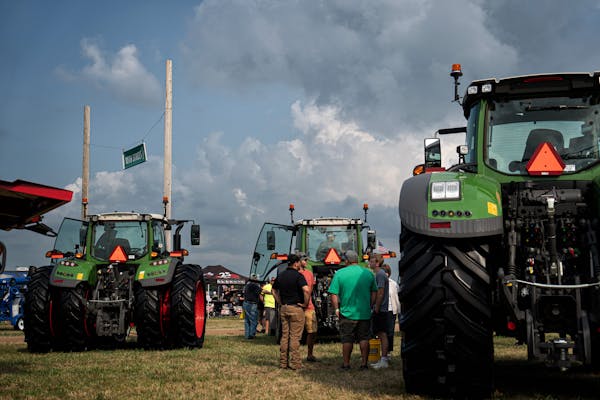ST. PETER, Minn. — Dan Coffman took a break Friday from harvesting his crop and walked to the back of the lean-to on his machine shed.
He opened one of the huge white totes stacked there marked "Lane Ridge Farm." They're filled with an innovative wheatgrass called Kernza, backed up and waiting to go somewhere. Large metal grain bins of it stand outside too.
"I still have half of my 2021 crop in storage, I have all of my 2022 crop in storage, and at this point I will have all of my 2023 crop in storage with no market available to me," Coffman said. He decided to plant only 10 acres of Kernza next year, down from 30.
"After that I'm going to have to see if the market picks up," Coffman said. "It's tough to run a business without generating an income off acres."
Billed as the new wonder grain — a wheatgrass with a nutty, graham or rye-like flavor — Kernza uses very little nitrogen fertilizer, and its extremely long roots make it a powerhouse at soaking up nitrogen that would otherwise seep into groundwater, research has shown. It's the type of eco-crop promoted for farm country to help cut the nitrate leaching from nitrogen fertilizers into the state's waters.
Coffman is one of more than 50 farmers around Minnesota who grow Kernza now. Still, there are only about 1,400 acres in the state. That's more than any other state, but it's small — not much more than the state's acres of berries. It's a boutique grain. A 5-pound bag of Kernza baking flour costs $30 at Northfield-based startup Perennial Pantry, which Coffman sells to.
When asked why there are so few acres of an eco-crop in Minnesota when it's targeted as a nitrate-reduction tool, Coffman did not hesitate. No one is buying it. He wants to grow more of it for the water and environmental benefits — and because he finds growing corn and soybeans boring, he said.
"I think it just takes time for the general public to accept it or for it to become more mainstream," he said.
That's the core challenge many are working on, including the new Perennial Promise Grower's Cooperativein Lac qui Parle County. Coffman is part of the cooperative, which has hired a marketing company.
Boosters say Kernza's slow start doesn't mean it's doomed. Take soybeans. "It took 80 years from concept to really taking a strong hold in the marketplace," said Alexandra Diemer, business development director of novel supply chains for the Agricultural Utilization Research Institute in Crookston, Minn.
Kernza is moving much faster, Diemer said.
"Its root systems are insane," she said. "That's why it's such a star. It's like, 10 feet deep compared to 2 feet deep."
Products are popping up in numerous places thanks to help from the Research Institute and other advocates. Artisan Naan Bakery in St. Cloud churns out fresh Kernza naan, a flatbread, sold by some Twin Cities stores. Brewers make Kernza cream ale and other beers — even a Kernza whiskey by Tattersall Distilling. There are Kernza recipes in the Forever Green Cookbook by award-winning food writer Beth Dooley. General Mills' Cascadian Farm brand makes a Kernza cereal with honey oat clusters. Kernza Fest Wisconsin joined the Lake Pepin Legacy Alliance's annual benefit celebration last month.
But as a commercial crop, it's still at the very early stage, said Mitch Hunter, associate director of the University of Minnesota's Forever Green Initiative, a project developing new, environmentally friendly perennial and winter crops for farmers. He said he thinks Coffman's Kernza backed up because production expanded in 2020, and prices for end users were too high.
"It's easy to look at the market and say 'Why isn't it bigger yet?'" Hunter said. "I would say where we are right now is a mark of success. I think it's very reasonable to be impatient."
Meanwhile, researchers are busy with the Kernza plant itself.
The nonprofit Land Institute in Salina, Kan., started developing Kernza 20 years ago, and the U's Forever Green is developing it too, along with more than a dozen other alternative crops such as a perennial flax. The University of Minnesota released the MN-Clearwater Kernza variety in 2019, the type Coffman and most Minnesota farmers grow. It plans to have a new second variety to release to seed companies next fall, for 2025 planting.
The goal is to enlarge the grain's seed head, get a hull that releases from the kernel more easily and breed a shorter plant less likely to fall over in the field. They want to sustain Kernza yields and stop them from declining after two or three years in the field. Hunter is confident the U's 15-year Kernza breeding program will improve the grain's yields and lead to greater adoption.
They're also adding Kernza to an incentive program that pays farmers to grow alternative crops such as winter camelina. The Environmental and Economic Clusters of Opportunity (EECO) is funded through the state's sales tax-financed Clean Water Fund, which has boosted Forever Green spending 50% to $6 million for the next two years.
Top priority goes to farmers growing in drinking water supply management areas, the protected zones near community water wells, many of which are polluted by nitrate. Those growers get an additional 25% payment.
Meanwhile, the Legislature this spring appropriated $500,000 to the Department of Agriculture to make grants to grow the supply chain and markets for continuous-living crops such as Kernza.
Coffman will be watching. Steering his combine down the rows of Kernza last week in a field near St. Peter High School, he said he's trying to do something legendary for Lane Ridge, his family's Century Farm. He'll grow a smaller batch of Kernza next year. He's waiting for the market to take off.
Carolyn Parnell, 'trailblazer' who served as Minnesota's first IT commissioner, dies


